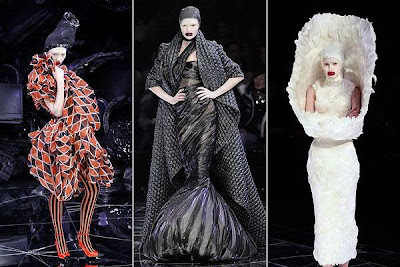His last Twitter comments:
Some excerpts from the New York Times:
Mr. McQueen often showed a dark streak in his collections, commenting on brutality toward women and what he saw as the inanity of the fashion world, and it carried over into his personal life. At the beginning of his career, Mr. McQueen became a sensation for showing his clothes on ravaged-looking models who appeared to have been physically abused, institutionalized or cosmetically altered, all while peppering his audience with rude comments. “I’m not interested in being liked,” he said. He once mooned the audience of his show.
But he was enormously creative and intelligent, and he seemed to sense that the fashion industry needed to have its buttons pushed. His fall 2009 collection was the talk of Paris when, reacting to the recession, Mr. McQueen showed exaggerated versions of all of his past work on a runway strewn with a garbage heap of props from his former stage sets. He was suggesting that fashion was in ruins.“The turnover of fashion is just so quick and so throwaway, and I think that is a big part of the problem,” he said. “There is no longevity.”
Aware of his homosexuality at an early age (he said he knew at age 8), he was taunted by other children, who called him “McQueer.” He left school at 16 and found an apprenticeship on Savile Row working for the tailors Anderson & Sheppard and then Gieves & Hawkes. In a story he repeated on some occasions but at other times denied, he was bored one day and wrote a derogatory slur in the lining of a jacket destined for the Prince of Wales.



McQueen's final collection: http://www.alexandermcqueen.com/int/en/corporate/experience_03.aspx
Complete New York Times article: http://www.nytimes.com/2010/02/12/fashion/12mcqueen.html?src=twt&twt=nytimes






